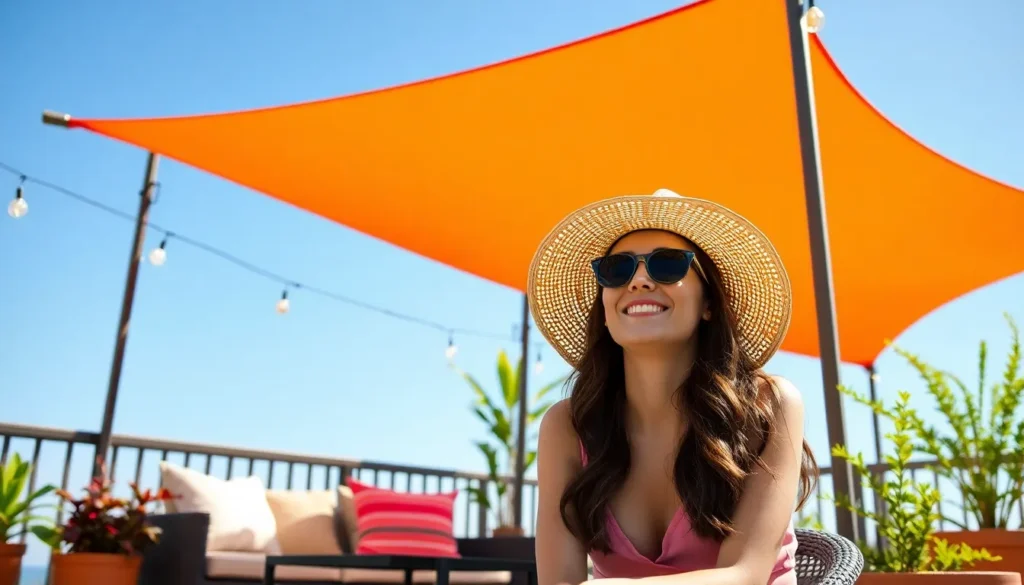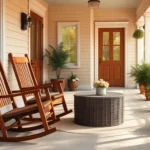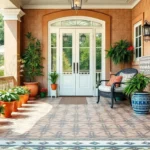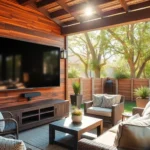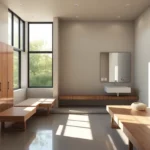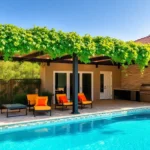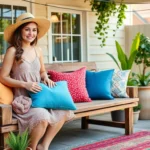When we think about transforming our outdoor spaces, shade sails emerge as one of the most stylish and practical answers for creating comfortable patio areas. These versatile fabric canopies don’t just shield us from harsh UV rays – they add architectural interest and define outdoor living spaces with their sleek, modern appeal.
We’ve discovered that shade sails offer incredible design flexibility, allowing us to customize our patios with unique configurations that traditional umbrellas simply can’t match. Whether we’re working with small balconies or expansive decks, these triangular or square canopies can be arranged in countless ways to maximize coverage while creating stunning visual impact.
The best part? Patio shade sails combine functionality with affordability, giving us professional-grade sun protection without the hefty price tag of permanent structures. From vibrant colors that make bold statements to neutral tones that complement existing décor, we’ll explore creative ideas that’ll transform your outdoor space into a shaded sanctuary you’ll actually want to spend time in.
Choose the Right Sail Shade Shape for Your Patio
Different patio configurations require exact shade sail shapes to maximize coverage and visual appeal. We’ll explore the three most popular options that work best for various outdoor spaces.
Triangle Sail Shades for Corner Coverage
Triangle sail shades excel at covering corner spaces and creating ever-changing visual interest in your outdoor area. These angular designs work perfectly for L-shaped patios, deck corners, and areas where you need to work around existing structures like pergolas or fire pits.
Installation becomes simpler with triangular sails since they require only three anchor points compared to four-sided options. We recommend using corner spaces, poolside areas, and compact patios as ideal locations for these versatile shade answers.
Triangular configurations offer excellent tension distribution, which means your shade sail will maintain its shape better over time. The pointed design creates natural water runoff during rain, preventing sagging and extending the fabric’s lifespan.
Rectangle Sail Shades for Maximum Coverage
Rectangle sail shades provide the largest coverage area for your investment, making them perfect for spacious patios and outdoor dining areas. These shapes work exceptionally well over long tables, outdoor kitchens, and rectangular pool decks where you need consistent shade across a wide area.
Four anchor points allow for superior stability and tension control, ensuring your shade sail stays taut even in windy conditions. We’ve found that rectangular sails create the most usable shaded space, accommodating multiple seating areas and larger gatherings.
Professional installation often works best with rectangular sails due to their size and the precision required for proper tensioning. These shapes complement modern home architecture and provide a clean, geometric look that enhances contemporary outdoor spaces.
Square Sail Shades for Balanced Protection
Square sail shades offer the perfect compromise between coverage area and installation flexibility. These shapes work beautifully over square patios, hot tubs, and central seating areas where you want symmetrical shade distribution.
Equal sides create balanced coverage that looks proportional in most outdoor settings. We particularly recommend square sails for patios with existing square features like fire tables, outdoor rugs, or geometric landscaping elements.
Mounting options remain flexible with square sails since all four sides are identical, allowing you to adjust the orientation based on your exact space constraints. The uniform shape provides consistent shade throughout the day as the sun moves across the sky.
Select Durable Materials That Withstand Weather
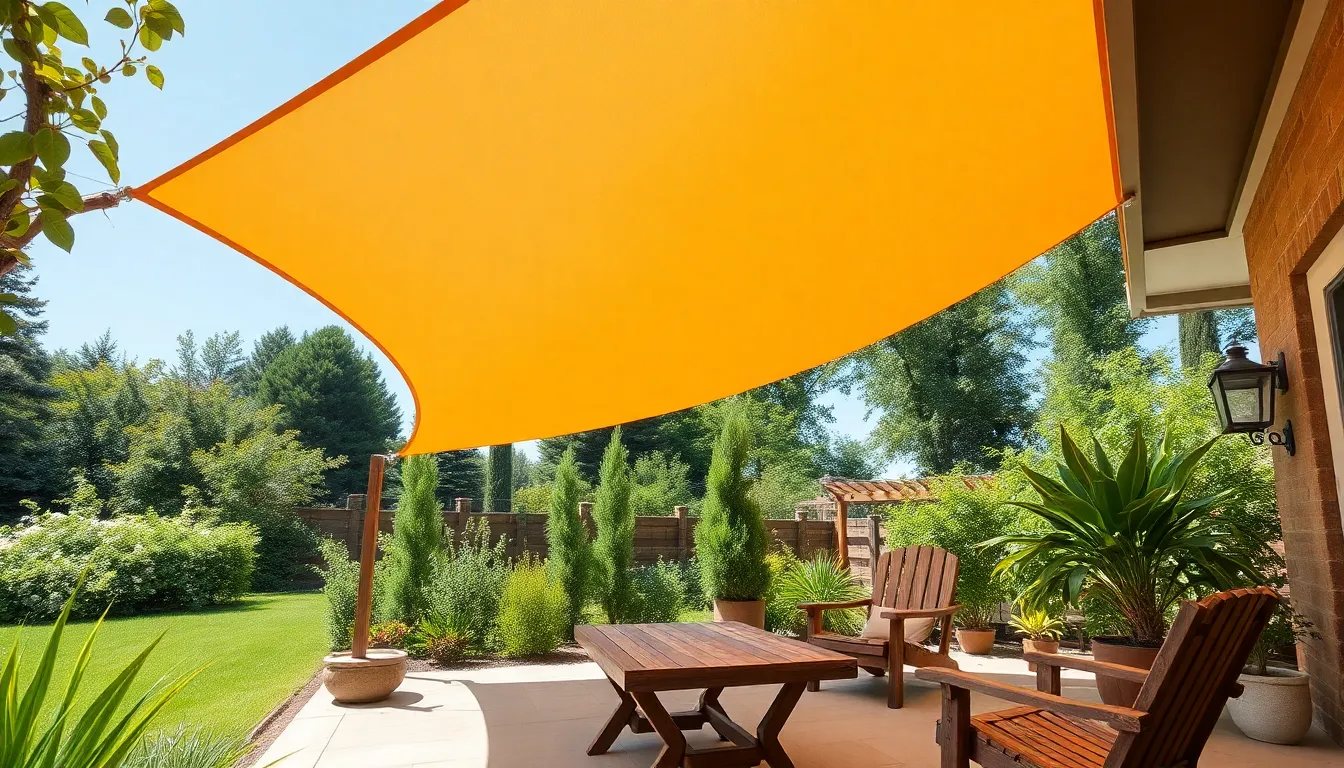
Choosing the right fabric material determines how well your shade sail performs against weather elements and UV exposure. Weather resistance becomes crucial for maintaining both functionality and appearance over multiple seasons.
HDPE Fabric for UV Protection
High Density Polyethylene (HDPE) fabric offers superior UV protection with specialized construction that blocks over 95% of harmful UVA and UVB rays. Polytex+ represents one of the most advanced HDPE options, featuring a knitted “Raschel Knit” construction that resists tearing and fraying while maintaining flexibility.
Breathability sets HDPE apart from solid materials because the fabric allows air circulation while providing effective shade coverage. This design prevents heat buildup underneath the sail, creating cooler outdoor spaces compared to non breathable alternatives.
Strength to weight ratio makes HDPE practical for installations where structural load matters. The fabric’s fire rated properties add an extra safety consideration for patios near grilling areas or fire features.
Canvas Materials for Classic Appeal
Canvas materials deliver traditional elegance that complements classic patio designs and architectural styles. These natural looking fabrics provide moderate durability while offering a timeless aesthetic that works well with brick, stone, or wood outdoor elements.
Maintenance requirements increase with canvas options since these materials typically need waterproofing treatments and regular care to withstand weather effects. The trade off involves more upkeep in exchange for visual appeal that matches traditional outdoor decor.
Color retention varies with canvas quality depending on the exact weave and treatment applied during manufacturing. Higher quality canvas options maintain their appearance longer but still require periodic maintenance to preserve their classic look.
Waterproof Options for Rain Protection
Waterproof fabrics prevent water penetration through specialized coatings or treatments that create a barrier against rain and moisture. These options work best for patios where complete weather protection matters more than maximum breathability.
Breathability trade offs occur with waterproof materials since the coatings that repel water also reduce air circulation underneath the shade sail. This can create warmer conditions during sunny weather compared to breathable alternatives like HDPE mesh.
Coated canvas combines classic appeal with rain protection by applying waterproof treatments to traditional canvas materials. Specialized synthetic fabrics also offer waterproof capabilities while maintaining some flexibility and durability for demanding weather conditions.
Plan Your Mounting Points and Installation
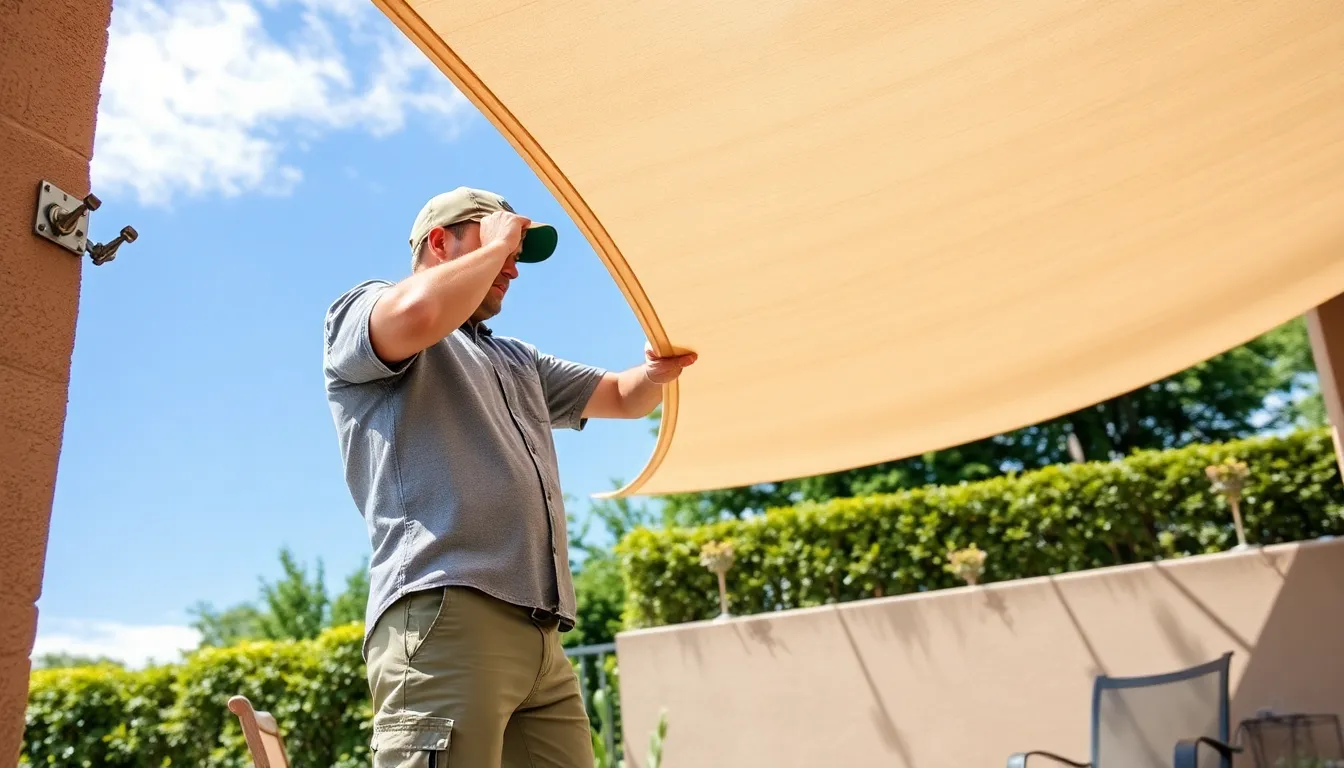
Once we’ve selected our ideal shade sail shape and material, we need to focus on creating a secure mounting system that’ll keep our installation safe and effective. Proper planning of anchor points determines both the longevity and performance of our shade sail setup.
Existing Structure Attachment Points
Existing structures on our property often provide the strongest and most convenient mounting options. We can use sturdy points on our house, garage, or existing patio roof as anchor points for the shade sail, which avoids installing extra posts and simplifies the entire process.
Mounting hardware selection requires careful attention to load capacity and durability. We’ll need to attach eye bolts, wall mounts, or heavy duty hooks securely into solid structural elements like beams or masonry. Each attachment point should handle at least 100 lbs of tension force to keep the sail taut and safe during use.
Location selection demands consideration of sun angles and shade coverage needs. We should mark our selected mounting spots clearly before installation and ensure they align with our patio’s traffic patterns. Weather resistant hardware like stainless steel components ensures our attachment points remain reliable through seasons of outdoor exposure.
Dedicated Pole Installation Options
Dedicated poles become necessary when existing structures don’t provide suitable mounting points. We’ll typically set these poles in concrete footings for maximum stability, using pole diggers and concrete mix to create permanent anchor points around our patio area.
Pole height and positioning affect both coverage and water drainage capabilities. We should install mounting brackets and pole clamps slightly lower than house anchors to help proper water runoff. Typical pole height measures about 12 feet, though we can adjust this based on our sail size and desired coverage area.
Installation location must account for wind loads and structural integrity. We need to check local regulations since some installations require permits or engineering assessments, especially for permanent post installations. Proper spacing between poles ensures even tension distribution across our shade sail fabric.
Wall and Fence Mounting Answers
Walls and fences can serve as effective mounting anchors when they’re structurally sound. We must attach secure hardware appropriate for the exact surface type, ensuring it can bear the tension load without compromising the structure’s integrity.
Fence mounting requires verification of the fence posts and material strength. We should confirm that existing fence components can handle stress without damage or collapse before committing to this mounting method. Reinforcement may be necessary for older or lightweight fence installations.
Hardware selection and installation techniques vary by surface material. We’ll use stainless steel or weather resistant hardware to ensure durability in outdoor conditions. Masonry surfaces require different mounting approaches than wood or vinyl materials, so we must match our installation method to the exact wall or fence type we’re working with.
Create Multi-Level Shade Configurations

Multi-level configurations transform ordinary patio spaces into ever-changing outdoor environments that maximize both comfort and visual appeal. We’ll explore three effective approaches that combine different sail heights to create superior shading answers.
Overlapping Sail Arrangements
Overlapping multiple sails in different sizes creates a layered effect that significantly increases UV protection across your patio space. We recommend positioning larger sails as base layers with smaller accent sails mounted above to create depth and visual interest. Commercial grade materials enhance the longevity of overlapping arrangements while providing superior resistance to sun damage.
Different colored sails in overlapping configurations add striking design elements that transform your outdoor area into an architectural focal point. We suggest combining neutral base tones with bold accent colors to create contrast without overwhelming your existing patio aesthetic. This layering technique expands your shaded footprint beyond what single sail installations can achieve.
Strategic overlap positioning ensures maximum coverage during peak sun hours while maintaining adequate airflow between layers. We position overlapping sections to account for seasonal sun path changes, creating consistent protection throughout the year.
Staggered Height Installations
Staggered height mounting creates multi-dimensional shade effects that boost ventilation and reduce heat buildup beneath your sail configuration. We install sails at varying elevations to mimic natural shade patterns found in forest canopies, allowing cooler air to circulate more effectively. This approach manages sun shadows throughout the day as solar angles change.
Different mounting heights enable better adaptation to your patio’s unique sun exposure patterns during morning and afternoon hours. We recommend positioning higher sails toward the east to capture early morning sun while lower western sails provide afternoon protection. This staggered system maximizes comfort across different times of day.
Height variation reduces wind flapping through improved tension distribution, extending the lifespan of your sail installation. We achieve optimal performance by creating gentle slopes between attachment points rather than dramatic elevation changes.
Layered Shade Systems
Layered systems provide customizable shade levels that adapt to changing sunlight direction and intensity throughout seasons. We design these configurations using sun path studies to ensure expanded coverage where sunlight exposure is strongest. Multiple layer arrangements allow you to adjust protection levels based on exact weather conditions and usage needs.
Strategic layering combines functional benefits like enhanced UV protection with decorative considerations such as color contrast and architectural impact. We recommend incorporating the Hypar shape principle in layered designs, using high and low fixing points to improve durability and tension stability. This technique creates varied shaded zones while maintaining structural integrity.
Versatile layering answers accommodate different patio sizes and sun exposure patterns through modular design approaches. We tailor each layer’s position and size to complement your outdoor space’s unique characteristics, ensuring optimal performance and aesthetic appeal year round.
Incorporate Color and Design Elements
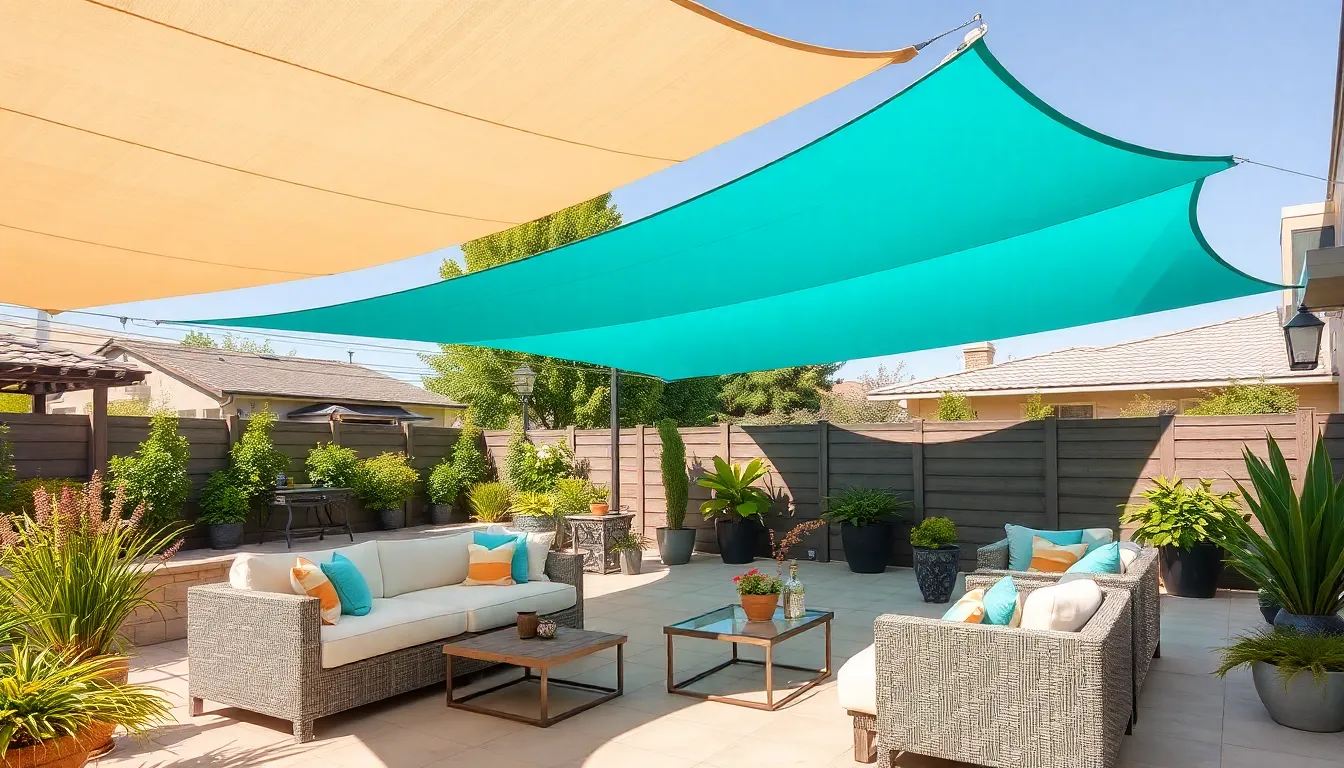
Color and design choices transform functional shade sails into stunning focal points that complement your outdoor aesthetic. We’ll explore how strategic color selection and pattern integration can elevate your patio’s visual appeal while maintaining optimal functionality.
Neutral Tones for Versatile Appeal
Neutral shade sails offer the most flexibility when designing your outdoor space. Beige, gray, off-white, and soft taupe colors blend seamlessly with any exterior color scheme, creating a sophisticated backdrop that won’t clash with existing landscaping or furniture. These understated tones complement both modern minimalist patios and traditional outdoor settings without overwhelming the space.
We recommend neutral sails for homeowners who frequently update their outdoor decor, as these colors provide a timeless foundation that adapts to changing styles. The calming atmosphere created by neutral tones makes them perfect for relaxation areas where you want the focus on comfort rather than bold design statements. Also, neutral colored sails maintain their appearance longer since they don’t show dirt and weather wear as readily as lighter or darker alternatives.
Bold Colors for Statement Pieces
Bold colored shade sails create dramatic focal points that inject personality into your patio design. Deep blue, vibrant red, mustard yellow, and turquoise options make excellent statement pieces that draw the eye upward and add contemporary flair to your outdoor space. These saturated colors work particularly well in modern settings where you want to emphasize architectural elements or create visual interest.
We suggest using multiple bold colored sails in overlapping or layered patterns to create ever-changing artistic displays that elevate your patio’s overall aesthetic. The key lies in balancing these vibrant elements with neutral outdoor furniture and accessories to prevent visual overload. Bright colors also serve practical purposes by creating easily identifiable gathering spaces in larger outdoor areas.
Patterned Sails for Visual Interest
Patterned shade sails introduce texture and uniqueness that plain colored options simply can’t achieve. Stripes, geometric shapes, and organic motifs break up monotonous expanses while adding depth and customization to your shaded areas. These designs work exceptionally well when paired with solid colored outdoor furniture to maintain visual balance.
We find that patterned sails create more intimate feeling spaces by adding complexity without overwhelming the design. The visual texture helps define different functional areas within larger patios, making them feel more intentional and inviting. Geometric patterns particularly complement modern architectural styles, while organic motifs blend beautifully with natural landscaping elements.
Maximize Functionality with Adjustable Features
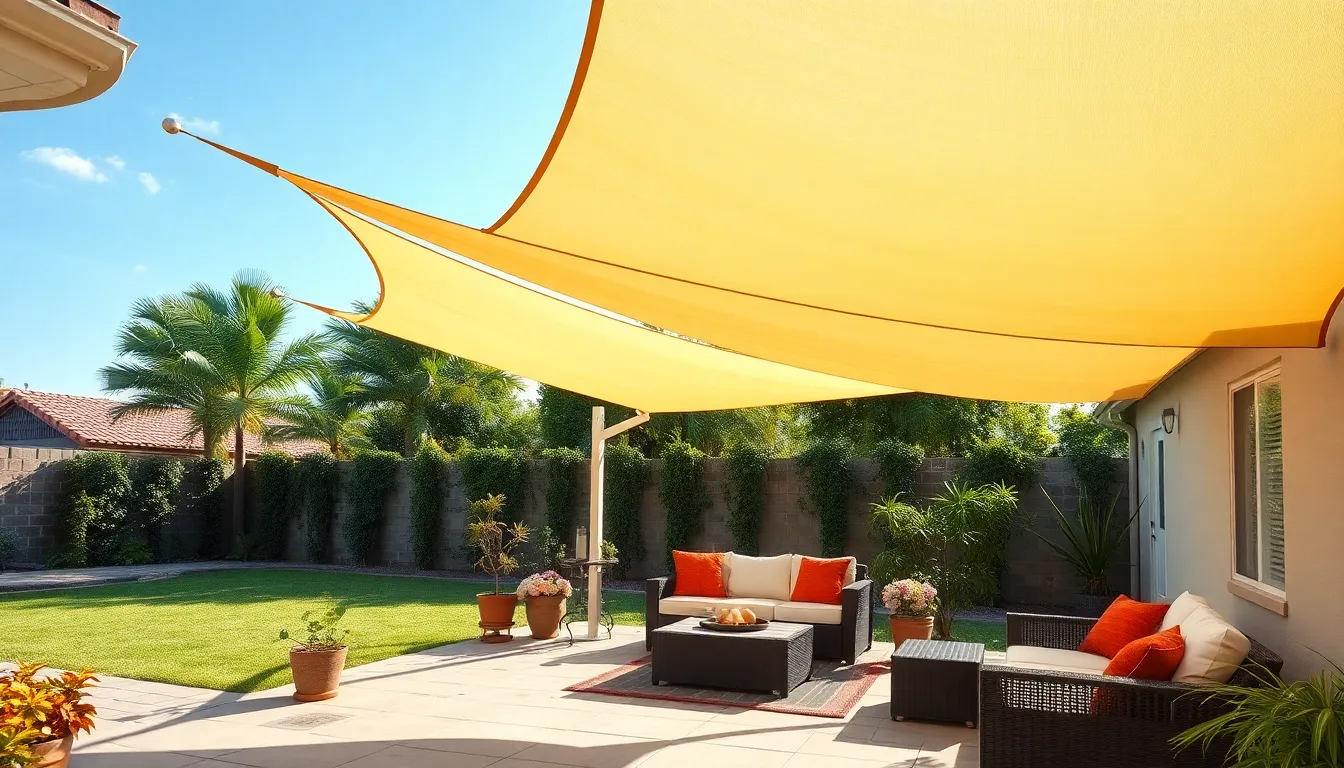
We can transform our patio shade sails from static installations into ever-changing, responsive systems that adapt to changing conditions throughout the day and seasons. Adjustable features elevate the functionality of shade sails by allowing us to customize coverage based on sun position, weather patterns, and seasonal needs.
Retractable Sail Shade Systems
Retractable systems offer us the ultimate flexibility in managing our outdoor shade coverage. Manual retractable shade sails provide simple, reliable answers that open and close in under 3 minutes without requiring any maintenance. These systems work perfectly for patios and balconies where we need adjustable shade with minimal fuss.
Motorized retractable shade sails elevate our convenience with automated operation that opens or closes the sail in under a minute with one touch control. Modern motorized systems are ideal when we’re seeking smart and stylish outdoor sun protection that integrates seamlessly with our contemporary lifestyle. Both manual and motorized options improve our outdoor usability by enabling quick adjustments based on sun position and changing weather conditions.
Removable Seasonal Options
Seasonal removal capabilities allow us to adapt our shade systems to changing weather patterns throughout the year. Retractable systems inherently support seasonal adjustments by rolling up completely when we don’t need them during cooler months or stormy seasons.
Alternatively, we can quickly detach sails using adjustable attachment hardware that allows us to store them during winter or particularly windy seasons. This approach helps us extend the lifespan of our shade sails while maintaining material quality by protecting them from harsh weather conditions when shade isn’t necessary.
Tilting Mechanisms for Sun Tracking
Tilting mechanisms enable us to angle our shade sails to track the sun’s path throughout the day for enhanced coverage. Adjustable rails with multiple positions help this capability by letting us set both height and angle to block direct sunlight effectively as the sun moves across the sky.
We can use shade sail rails with adjustable eyes that allow us to alter tension and height in increments of 5 cm steps across 20 positions for optimal sun protection. High quality aluminum hardware enhances durability in outdoor conditions while providing the precision control we need. These tilting features ensure maximal comfort and protection from glare and UV rays by maintaining effective shade coverage from morning to evening.
Combine Sail Shades with Other Patio Elements
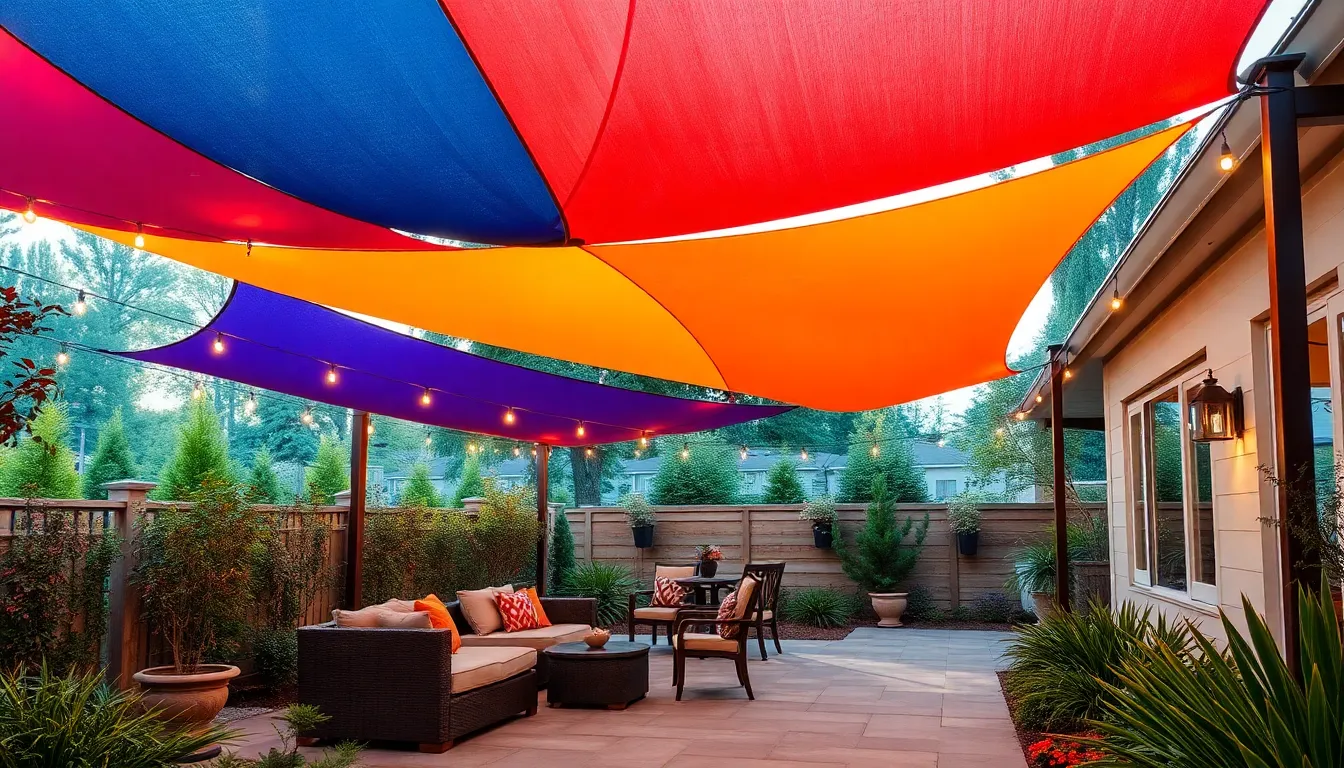
Creating a cohesive outdoor space requires thoughtful integration of shade sails with existing patio features. We’ll explore how strategic placement and design coordination can transform your patio into a unified, functional retreat.
Integration with Outdoor Furniture
Shade sails provide flexible coverage that transforms ordinary furniture arrangements into defined outdoor rooms. We recommend positioning your sails to create comfortable zones over seating areas, dining sets, and loungers, protecting both people and furniture from harmful UV rays and excessive heat. Multiple sails at varying heights and angles enhance visual appeal while maximizing coverage across different activity areas.
Strategic placement turns simple patio setups into inviting outdoor spaces that feel intentionally designed. We suggest using sails to frame furniture groupings, creating natural boundaries between dining and lounging areas. This approach protects valuable outdoor furniture from sun damage and fading, extending its lifespan while maintaining comfort for guests.
The flexible nature of sail shades allows you to adapt coverage as furniture arrangements change throughout the seasons. We find that positioning larger sails over primary seating areas and smaller ones over accent pieces creates a balanced, layered look that serves both aesthetic and functional purposes.
Pairing with String Lights
String lights complement shade sails beautifully, adding warmth and ambiance to your outdoor space. We recommend hanging string lights underneath or adjacent to your sails, using the smooth fabric surface as an ideal backdrop for evening illumination. This combination creates a cozy, festive atmosphere that extends patio usability into nighttime hours.
The stretched fabric of sail shades provides excellent support points for string light installation. We suggest running lights along the edges of triangular sails or creating grid patterns under rectangular configurations for even light distribution. This pairing preserves comfortable shade during the day while delivering practical lighting for evening gatherings.
Layering lights with multiple sail configurations creates depth and visual interest in your outdoor space. We’ve found that combining warm white LED strings with colored sails produces particularly striking effects, turning your patio into an inviting retreat that works from sunrise to sunset.
Coordination with Landscaping
Shade sails integrate seamlessly with landscaping elements when positioned to complement natural features like trees, shrubs, and garden beds. We recommend choosing sail colors that harmonize with your existing plant palette, using the structures to frame and accentuate outdoor spaces rather than compete with them. Strategic placement near patios or pathways creates shaded zones that feel naturally integrated into the industry design.
Planning your sail layout according to sun movement throughout the day and across seasons ensures effective shading without obstructing plant growth. We suggest positioning sails to work with existing trees, using them as natural anchor points while providing supplementary shade where canopy coverage falls short. This approach maximizes both natural and artificial shade sources.
Overlapping multiple sails in various colors and sizes creates ever-changing visual appeal that complements diverse landscaping styles. We recommend using hypar shapes with alternating high and low points to increase tension and prevent flapping, ensuring your sails maintain their architectural impact while harmonizing with garden elements throughout changing weather conditions.
Budget-Friendly DIY Installation Tips

Installing shade sails doesn’t require professional expertise or expensive equipment when you approach it strategically. We’ve found that proper planning and smart material choices can significantly reduce costs while ensuring a durable, attractive installation.
Cost-Effective Material Sourcing
Start with UV-resistant fabric options like polyester and HDPE materials that offer excellent durability without premium pricing. These fabrics prevent fading and withstand weather conditions effectively, making them ideal choices for budget-conscious homeowners.
Purchase complete hardware kits from home improvement stores or online retailers to get the best value on mounting components. These bundles typically include eye bolts, turnbuckles, D-shackles, and brackets at a fraction of individual part costs.
Consider DIY kits over custom answers as they often include detailed instructions and pre-selected materials designed to work together. Ready-mix concrete provides an affordable option for securing ground poles when existing structures aren’t available for mounting.
Compare prices across multiple suppliers to find the best deals on fabric and hardware combinations. Many online retailers offer competitive pricing on complete shade sail packages that include everything needed for installation.
Simple Installation Techniques
Begin by marking your mounting points after considering sun angles and wind exposure patterns for optimal shade coverage and structural stability. Accurate measurements help ensure proper tensioning and prevent installation errors.
Install mounting hardware securely using appropriate fasteners for your chosen anchor points, whether they’re existing walls, posts, or dedicated ground anchors. For new pole installations, dig holes approximately 2 feet deep and secure with concrete mix.
Connect your shade sail systematically using D-shackles or stainless steel wire to link the fabric to mounting points, incorporating turnbuckles for tension adjustment. This hardware allows you to achieve the proper tautness without over-stressing the material.
Hang the sail with assistance to prevent twisting and ensure even distribution across all attachment points. Gradual tensioning through turnbuckle adjustments helps achieve optimal fabric tightness while maintaining structural integrity.
Maintenance and Care Guidelines
Inspect tension and hardware regularly to identify any loosening that might compromise the sail’s performance or safety. We recommend checking turnbuckles monthly and re-tightening as needed to maintain proper fabric tautness.
Clean your shade sail gently using mild soap and water answers rather than harsh chemicals that can degrade the material over time. Regular cleaning prevents dirt buildup and extends the fabric’s lifespan significantly.
Remove sails during extreme weather in regions prone to heavy storms or snow loads to prevent damage and prolong their useful life. Seasonal removal also allows for thorough cleaning and inspection of both fabric and hardware.
Monitor for potential chafing points where the sail might contact tree branches or nearby structures that could cause premature wear. Maintain at least 18 inches of spacing between multiple sails to prevent fabric-to-fabric friction damage.
Conclusion
Creating the perfect shaded outdoor retreat with sail shades doesn’t have to be overwhelming or expensive. We’ve shown you how these versatile canopies can transform any patio space while providing essential protection from harmful UV rays.
The key is choosing the right combination of shape material and mounting strategy that works for your exact space and budget. Whether you opt for a simple triangle installation or create an elaborate multi-level design the results will enhance both comfort and visual appeal.
With proper planning and our DIY installation tips you’re well-equipped to tackle this project confidently. Your patio will soon become the inviting outdoor sanctuary you’ve always wanted.
Frequently Asked Questions
What are shade sails and what benefits do they provide?
Shade sails are fabric canopies that provide UV protection while adding architectural interest to outdoor spaces. They offer design flexibility that traditional umbrellas cannot match, transforming patios, balconies, and decks into inviting shaded retreats. These versatile structures are an affordable alternative to permanent installations and come in various colors to suit different aesthetics.
What are the most popular shade sail shapes and their advantages?
The three main shapes are triangle, rectangle, and square sails. Triangle sails are ideal for corner coverage requiring only three anchor points. Rectangle sails provide maximum coverage for spacious patios. Square sails offer balanced protection with installation flexibility. Each shape provides unique benefits like improved tension distribution and stability in windy conditions.
What materials are best for durable shade sails?
High Density Polyethylene (HDPE) fabric is ideal for superior UV protection, breathability, and strength-to-weight ratio. Canvas materials offer classic appeal but require more maintenance. Waterproof options provide rain protection with reduced breathability. Coated canvas and specialized synthetic fabrics combine aesthetic appeal with functional benefits for various weather conditions.
How do I properly install shade sails?
Start by identifying secure mounting points using existing structures like houses or garages when possible. Select appropriate mounting hardware based on load capacity requirements. For dedicated pole installations, use concrete footings and ensure proper height for optimal coverage. Always verify the strength of walls and fence posts before mounting.
Can I create multi-level shade configurations?
Yes, multi-level configurations enhance both functionality and visual appeal. Options include overlapping sails for increased UV protection, staggered height installations for better ventilation, and layered systems for customizable shade levels. These advanced configurations maximize comfort while creating architectural impact in outdoor spaces.
What colors and design options work best for shade sails?
Neutral tones like beige and gray offer versatility and timeless appeal, while bold colors like deep blue and red create dramatic statements. Patterned sails with stripes or geometric shapes add texture and visual interest. Choose colors that complement your existing outdoor decor and desired aesthetic impact.
Are there adjustable shade sail options available?
Yes, retractable shade sail systems offer customizable coverage based on sun position and weather. Manual and motorized options provide flexibility for managing outdoor shade. Removable seasonal sails adapt to changing weather conditions, while tilting mechanisms allow for sun tracking and optimal coverage throughout the day.
Can I install shade sails myself on a budget?
Absolutely! DIY installation is cost-effective without professional help. Source UV-resistant fabrics like polyester and HDPE, and purchase complete hardware kits for better value. Use simple techniques: mark mounting points, secure hardware properly, and connect sails with appropriate tensioning methods for successful installation.
How do I maintain my shade sails?
Regular maintenance includes periodic inspections for wear, gentle cleaning with mild soap and water, and seasonal removal during extreme weather. Proper tensioning prevents fabric stress, and storing sails during harsh conditions extends their lifespan. Check mounting hardware regularly to ensure continued safety and performance.
How can I integrate shade sails with my existing patio design?
Position sails strategically over seating areas and dining sets for maximum functionality. Coordinate colors with existing outdoor furniture and decor elements. Pair shade sails with string lights for added ambiance, and complement landscaping features to create a cohesive, harmonious outdoor environment that feels intentional and inviting.

